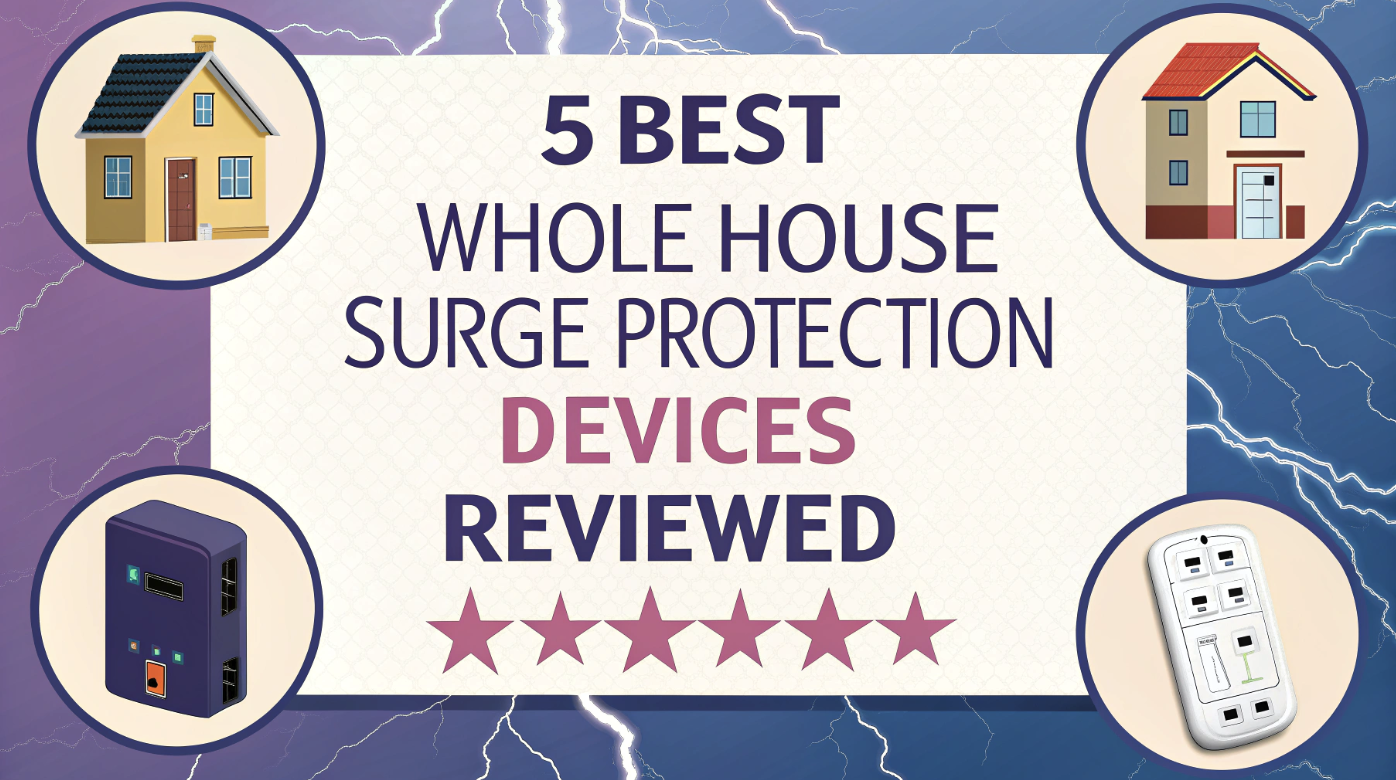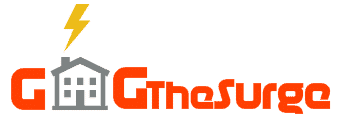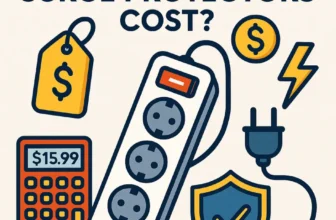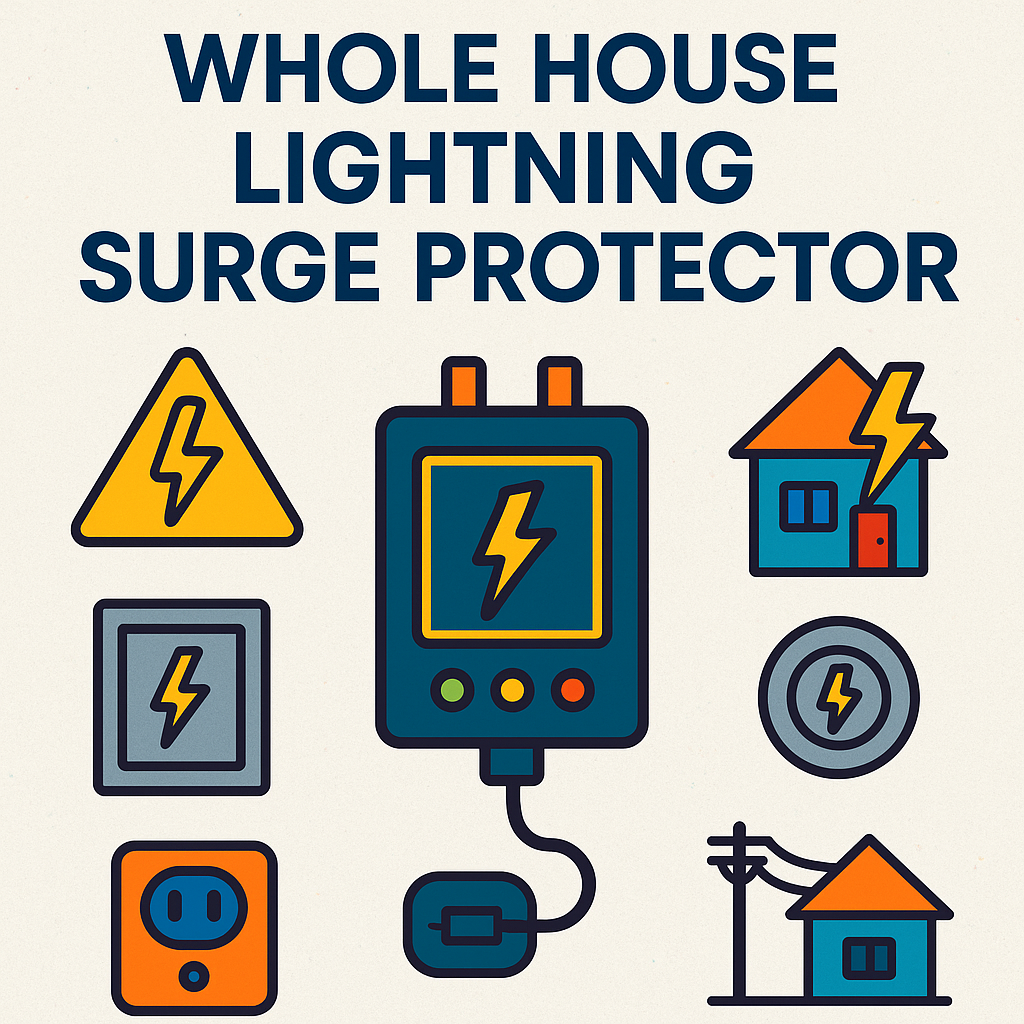Published By: Marc Edwards | Last updated on July 25, 2025 and reviewed by Editorial Team

One of my clients, Tom, moved into his new apartment in Oklahoma City, Florida last month.
As Florida is a lightning-prone state, Tom decided to install a whole house surge protector at the electrical panel.
To his dismay, a storm came by a few days later, and his old trusty home entertainment system was fried.
He called me and asked what could have happened.
I told him the excess voltage from the lightning could have “escaped” through his whole house surge suppressor and damaged his home entertainment system.
These days, it takes more than setting up whole house surge protection to fully (100%) protect your prized home electronics and appliances from super-charged lightning strikes and irregular power voltages and transients.
Having a Type 2 surge protector installed at the circuit breaker panel may no longer be sufficient if you are staying near a lightning-prone area.
Two-tiered surge protection is required and recommended for homeowners.
Most homeowners are unaware that installing a whole house surge protection device (at the service panel) alone could only suppress up to 80% of all voltage surges.
That means there are still some 20% of voltage currents that will ‘bypass‘ the whole house surge protection device hardwired at the service panel.
These damaging voltage currents will potentially seek out and cause damage to connected home electronics and appliances in the house.
This is where the second layer of surge protection comes into play.
To achieve 90% protection against most power surges, point-of-use surge protection devices are also required as the last line of defense for home appliances and electronic devices connected to them.
If you really want near 100% foolproof surge protection, we highly recommend hiring a licensed electrician and having him replace all standard electrical AC outlets in the house with surge suppressor receptacles.
- What is Whole House Surge Protection and is it Worth the Investment?
- Who Should Get Whole House Surge Protection Devices?
- Who Should Not Get it?
- Whole House Surge Protector Installation - Things to Know
- Which Brand of Whole House Surge Protection Device Should You Get?
- Whole House Surge Protection - Frequently Asked Questions
- Bottom Line - Should You Get One?
What is Whole House Surge Protection and is it Worth the Investment?
Most people tend to overthink what surge protection really is. In reality, it is not as complex as most people would think. Think of it as a water filtering device where only purified water can flow through and the filter blocks all impurities.
A typical whole house surge protection device performs the exact same thing. It only allows for safe electrical currents and filters out irregular voltages from the power utility, protecting your home appliances from being affected by harmful and damaging external electrical surges.
In case you have never set up a whole house surge protector before, be prepared to fork out a bit of cash to hire an electrician to hardwire it into your service panel if you are technically challenged.
Whole-house surge protectors are definitely worth the investment when it comes to having peace of mind knowing that all your costly electrical possessions at home are safe and sound when you are out at work or on vacation.
Spending a couple of hundreds of dollars is a worthy investment to safeguard electrical possessions that may be worth tens of thousands of dollars.
It is worth every dollar, in my opinion.
Who Should Get Whole House Surge Protection Devices?
Homeowners in Lightning-Prone Areas:
If you live in an area with frequent thunderstorms and lightning strikes, investing in a whole house SPD is highly recommended. Lightning-induced surges can cause extensive damage to electronic devices and electrical systems.
High-Value Home Electronics:
If you own expensive and sensitive electronic equipment, such as home entertainment systems, gaming consoles (like PS5 and XBox), and high-end appliances, a whole house SPD could help safeguard your investments against power surges.
Home Office and Work-from-Home Setups:
Professionals relying on their home office equipment for work should consider whole house SPDs. Safeguarding digital assets like computers, printers, and networking equipment will ensures uninterrupted productivity.
Who Should Not Get it?
Limited Electronics and Appliances:
If your home has minimal electronics and appliances, the investment in a whole house SPD might not be justified. Individual surge protectors for important devices could be more suitable.
Low-Risk Areas:
In regions with minimal lightning activity and stable utility grids, the risk of power surges might be lower. In such cases, basic surge protection measures could suffice.
Budget Constraints:
Whole house SPDs can be an investment. If your budget is limited and you don’t possess extensive electronics, allocating resources to other home improvements might take precedence.
Whole House Surge Protector Installation – Things to Know
Although the whole house surge protection devices are capable of blocking up to 80% of all surges, they are unlike point-of-use surge protectors which are plug-and-play simple.
Panel-mounted surge protection will require you to open your breaker panel and make changes to the main power feed and circuitry.
Below are some key points to consider before attempting the installation.
| Step | Procedure |
|---|---|
| 1 | Select the Surge Protector: Choose a whole house surge protector that is compatible with your electrical panel and meets your voltage requirements. |
| 2 | Turn Off Main Power: Locate your home’s main electrical panel and turn off the main power switch to ensure safety during installation. |
| 3 | Choose Installation Location: Decide on a suitable location for mounting the surge protector. It’s often installed near the main electrical panel. |
| 4 | Mount Surge Protector: Attach the surge protector to the chosen location using the provided mounting hardware. Ensure proper grounding. |
| 5 | Connect Grounding Wire: Connect the grounding wire from the surge protector to a grounding point, typically a ground bar in the electrical panel. |
| 6 | Open Electrical Panel: Open the main electrical panel cover and locate a knockout hole for routing the surge protector’s wires. |
| 7 | Route the wires from the surge protector through the knockout hole and into the electrical panel. |
| 8 | Connect Wires: Connect the surge protector’s wires to the designated breaker or bus bar in the electrical panel. Follow the manufacturer’s instructions. |
| 9 | Close Panel Cover: Securely close the main electrical panel cover, ensuring all connections are properly made. |
| 10 | Turn On Main Power: Turn the main power switch back on and verify that the surge protector’s indicator lights are functioning. Conduct a system test if applicable. |
Please note that the above is a brief overview of how a whole-house surge suppressor can be installed. If you are unsure about what to do, always hire a licensed electrician to do the job. Follow the safety procedures strictly and you will have a higher chance of success.
There are many brands and models available both online and offline at the malls but there are only five leading brands that we recommend. Take a few minutes to read through the reviews of each brand below and decide for yourself which brand is the most suitable fit for your home. 🙂 There are not many SPDs out there that have the capability to support a huge variety of Type 1 and Type 2 applications. Type 1 applications include outdoor installations before service entrances and utility meter cabinets. Type 2 applications include installations after service entrances. Even if you have difficulty in installation, there is free-of-cost Amazon tech support that comes with the purchase. The easy-to-use monitoring feature of this surge suppressor device also offers six modes of surge protection, giving you deep peace of mind knowing that it is constantly protecting all your prized electronics and appliances at home. Despite its high price point, it is definitely a worthy investment to protect your home against any unwelcome high-voltage spikes. Product Dimensions : 6.5 x 8.3 x 8 inches Item Weight: 2 pounds Item Model Number: IG1240RC3 Warranty: Connected equipment coverage $10,000 for 5 years FirstSurge has a response time of less than 1 nanosecond when it comes to providing a 3-stage commercial-grade notification to all commercial and residential applications. Like most SPDs, it is also compatible with any brand of load center and breakers. What we are most impressed with is that it comes with both audio and visual notifications. There is an audible alarm built in that will eliminate any guesswork, letting us know when it is time to have it replaced when its protective juice runs out. It also comes with both green and red flashing LED indication lights. In addition, it comes with a Type-4 outdoor enclosure rating and it can be installed inside the load center itself. It comes with a 10-year product and connected equipment warranty which is an obvious must-have given its asking price point. All in all, this FirstSurge device from Siemens will give you peace of mind that your home is in safe hands against any type of unexpected voltage surges. Product Dimensions : 10 x 6 x 4 inches Item Weight: 2.7 pounds Certification: UL / cUL 1449 listed Part Number: FS140 Color: 4 First off, this whole house surge protection device with its J-Box metal enclosures can also be deployed to commercial buildings where protection against high-voltage transients is required. This Leviton surge suppressor has been engineered to defend against high voltage spikes, most ideal for electrical devices like PDAs, laptops, PC and televisions. What we really like is that it comes with a real-time visual indicator that provides the status of the power and suppression during the protection phase. It also has the capability to help protect against internally generated transients which are usually between the circuit panel and the point of use where homeowners can make use of surge protection outlets, power strips, etc. Leviton 51120-1 Panel Protector comes with a 10-year limited lifetime warranty which is great for products in its range. Do bear in mind though that this device is strictly for indoor usage ONLY. This is probably the only downside we can think of. Product Dimensions : 8.3 x 8.2 x 5 inches Item Weight: 4.2 pounds Compliance: 3rd edition of the UL 1449 standard Part Number: 51120-1 Warranty period: 10 years limited warranty This 3rd Gen Type 2 whole house surge protection device can be connected to the main panelboard easily with its welded mounting bracket. Although the footprint of this EATON device is not big, it has the capability to block a maximum surge per phase of up to 108kA is pretty awesome in our opinion when used both outdoors and indoors. This widely popular transient voltage surge suppressor (TVSS) offers several protection modes. Although this is not a significant concern for us, we thought we would mention that the cable that comes with it is slightly short. But since most homeowners will be getting licensed electricians to do the work, this is usually of no concern to them. This EATON surge suppressor will obviously give you a good run for your money if you take into consideration of its ability to universally connect to any manufacturer’s load center (breaker box). Product Dimensions : 2.4 x 5.2 x 7.5 inches Item Weight: 1 pound Certification: NEMA/UL 1449 Part Number: CHSPT2ULTRA And if you are on a budget, do know that this surge suppressor is also the most affordable option compared to the rest. It features green LED indicator lights to confirm that the surge protection mode is active. HEPD80 is NEMA 4X rated for both outdoor and indoor usage and it comes with a good 5-year product warranty and a $50k residential down-line warranty. What we like most about this Square D surge protector device is that it provide well-balanced protection for all your electrical components throughout the entire household, including those NOT plugged into surge protection devices. Moreover, it comes with an individual Metal Oxide Varistor (MOV) that is separately fused. The only complaint we have is that the LED light seemed to be a little dim but it actually looks okay when you look at it from the circuit breaker panel. Product Dimensions : 2.7 x 3.8 x 3.6 inches Item Weight: 2.1 pounds Certification: CSA/NEMA/UL Part Number: HEPD80 Choosing a whole house surge protector is essentially the same as choosing a standalone surge protection strip like that of TLP1008TEL from Tripp Lite. The only difference is that some surge suppressors for the whole house do come with features like Ground-Fault Circuit Interrupter (GFCI) Protection which may potentially help prevent a fire hazard should there be a short circuit situation. Beyond that, you may also want to look for features like (FailSafe) power shutdown protection as well as the ability to help reset the circuit breakers. Most of us are probably more familiar with surge protection strips sold at retail stores than whole house surge protection devices, which are usually purchased online or through renovation contractors. There are many brands of whole house surge protection devices in the market but essentially, there are only 5 brands that stand head and shoulder above the rest. Read the product review of the 5 products above if you are looking to get a quality one for your home. We have included some images of those surge protection devices so take a look and see what they look like before you make your purchase. A whole-house surge protection device is capable of protecting your electrical devices from up to 80% of power surges. Unless you do not mind replacing all your prized electronics and appliances at home whenever there are power spikes, a whole house surge protection unit is a must-have. Especially if you stay near lightning-prone areas. This surge suppression device is definitely a worthy investment when it comes to protecting your expensive home appliances like home-theater systems, A/C units, fridges, dryers, ovens, and so on at home against power spikes that could render them useless in a matter of seconds. The cost varies depending on a few factors: Some home has a sub-panel because the distance between the appliances and the main panel is too far away and a sub-panel has to be put in place to bridge the distance. Hence, instead of receiving power from the power utility, the sub-panel receives power from the main panel. Different brands and models of whole house SPDs will obviously have different joules ratings (maximum surge current capacity) and different features and with that, they will naturally come with different price points. Needless to say, the more comprehensive and extensive the warranty, the more it will cost your wallet. This is again a variable cost depending on your budget. The more experienced and qualified electrician you hired to do the job, the more it will cost you. Be sure to verify the credentials of the company before engaging with them. Some companies have such a bad reputation that you would not want their technicians to install the whole house surge protection device for you. There are basically 2 types of power surges – External and Internal surges. External surges which form 20% to 25% of all surges are surges that generate from outside our house or building. For example, over-voltages from lightning strikes will tend to hit the nearby power lines causing a huge tidal wave of electrical current running into our household electrical panel and subsequently into our electrical appliances assuming no power suppressing devices are installed. Other common external surges include power current interruptions like power wires getting hit by strong winds, repair works, maintenance work at power utility which will all cause electrical disturbance on the power lines into our home. Internal surges which form more than 80% of all surges are usually generated continuously from electrical appliances’ power cycles on and off on a frequent basis. For example, a hot water dispenser will typically heat up the water a few times an hour causing very frequently electrical disturbances and surges. There are many brands of whole house surge protection devices available and we have reviewed 5 of the better brands in the market. Depending on your personal budget and preferences, be prepared to fork out between $95 to $250 for a decent quality SPD for your whole house. Be sure to read the product reviews of these 5 brands in this article for a better understanding of which one is the best fit for your home. The size of the whole house surge protection device varies depending on which brand you get it from. If you are looking to get one with a small footprint, the one by Square D and EATON would probably fit your need. Intermatic Smart Guard: 10.8 x 3.8 x 10 inches Siemens FS140: 10 x 6 x 4 inches Leviton 51120-1 Panel Protector: 8.3 x 8.2 x 5 inches EATON CHSPT2ULTRA: 2.4 x 5.2 x 7.5 inches Square D by Schneider Electric HEPD80: 2.7 x 3.8 x 3.6 inches Since our home is usually the single most expensive asset we own, it makes perfect sense to ensure everything inside the house, including all our beloved home appliances, are fully protected from power surges that could cause potential damages to them. Ultra-powerful voltage spikes (e.g. lightning strikes) could cause lots of electricity to pass through to our electrical devices all at once, causing them to either overheat or catch fire. Unless you don’t own expensive appliances at home, investing in whole-house surge protection devices is a necessary evil.Which Brand of Whole House Surge Protection Device Should You Get?
Intermatic Panel Guard IG1240RC3
 This panel guard features a Type 3R rainproof enclosure, suitable for both indoor/outdoor applications, made of plastic. What truly impressed us the most is that this Intermatic Panel Guard comes with state-of-the-art TPMOV (Thermally Protected Metal Oxide Varistor) technology to protect your entire home and home office from electrical disturbances and voltage spikes, bypassing the potentially dangerous failure modes that come with other standard MOV technology. There is also a green LED to indicate surge protection status.
This panel guard features a Type 3R rainproof enclosure, suitable for both indoor/outdoor applications, made of plastic. What truly impressed us the most is that this Intermatic Panel Guard comes with state-of-the-art TPMOV (Thermally Protected Metal Oxide Varistor) technology to protect your entire home and home office from electrical disturbances and voltage spikes, bypassing the potentially dangerous failure modes that come with other standard MOV technology. There is also a green LED to indicate surge protection status.Technical Specifications:
Siemens FS140
 This FirstSurge whole house surge protection device (Type-2 ) is NOT for homeowners on a budget. Despite its hefty price, it does come packed with lots of useful features which we thought is well worth its asking price.
This FirstSurge whole house surge protection device (Type-2 ) is NOT for homeowners on a budget. Despite its hefty price, it does come packed with lots of useful features which we thought is well worth its asking price.Technical Specifications:
Leviton 51120-1 Panel Protector
 Although this 4-Mode panel protector does come with a higher price point, we cannot ignore the fact that it has quite a bit of features packed into it.
Although this 4-Mode panel protector does come with a higher price point, we cannot ignore the fact that it has quite a bit of features packed into it.Technical Specifications:
EATON CHSPT2ULTRA
Technical Specifications:
Square D by Schneider Electric HEPD80
 Square D by Schneider Electric may have the smallest footprint among the five we recommend but it does pack a punch (80,000 amp Surge current rating) when it comes to protecting the entire house against internal and external catastrophic voltage spikes.
Square D by Schneider Electric may have the smallest footprint among the five we recommend but it does pack a punch (80,000 amp Surge current rating) when it comes to protecting the entire house against internal and external catastrophic voltage spikes.Technical Specifications:
Whole House Surge Protection – Frequently Asked Questions
1. What Does a Whole House Surge Protection Device Look Like?
2. Why do I Need a Whole House Surge Protection Unit?
3. Is Whole House Surge Protection Device Worth it?
4. How Much Does It Cost to Install a Whole House Surge Protection Device?
Do You Have Sub Panel that Leads to the Main Panel?
Type and Brand of Surge Protector
The Type of Warranty Provided
Who do You Hire to do the Job
5. Where Do Power Surges Come From?
6. How much are whole house surge protection units?
7. What is the size of a whole house surge protection device?
Bottom Line – Should You Get One?









